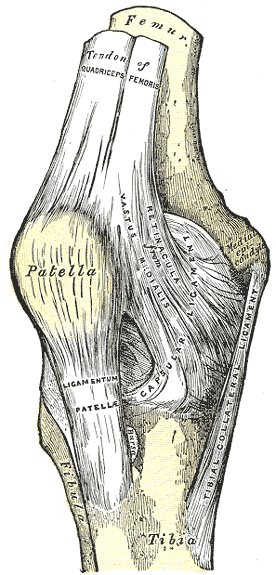Knee outcome survey: Difference between revisions
No edit summary |
m (moved location of the image) |
||
| (45 intermediate revisions by 7 users not shown) | |||
| Line 1: | Line 1: | ||
<div class="editorbox"> | <div class="editorbox"> | ||
'''Original Editor '''- | '''Original Editor '''- [[User:William Jones|William Jones]] | ||
'''Top Contributors''' - | '''Top Contributors''' - {{Special:Contributors/{{FULLPAGENAME}}}} | ||
</div> | </div> | ||
== Objective == | |||
The Knee Outcome Survey (KOS) is a patient-completed questionnaire that provides a percentage of disability during every day activities (activities of daily living subscale) or sports (sports activity subscale). The lower the percentage, the higher the disability. | |||
[[Image:Gray345.png|thumb|knee]] | |||
== Intended Population == | |||
The KOS is intended for a variety of knee disorders including [[Meniscal Lesions|meniscal tears]], [[Knee Osteoarthritis|osteoarthritis]] and [[Anterior Cruciate Ligament Injury|ACL tears]].<ref name="p1">Irrgang JJ, Snyder-Mackler L, Wainner RS, Fu FH, Harner CD. Development of a patient-reported measure of function of the knee. Journal of Bone Joint Surgery - American Volume 1998; 80-A(8):1132-1145.</ref> | |||
<br> | <br> | ||
== Method of Use == | |||
This is a self-report measure that is broken down into two categories (ADLs and sport activities) that rates perceived disability with 5 being "no difficulty" and 0 being "unable to perform".<ref name="p1" /> | |||
== Evidence == | == Evidence == | ||
=== Reliability === | === Reliability === | ||
The test-retest reliability coefficient (intraclass correlation coefficient[2,1]) was 0.97. These results suggest that the Activities of Daily Living Scale is a reliable, valid, and responsive instrument for the assessment of functional limitations that result from a wide variety of pathological disorders and impairments of the knee.<ref name="p1" /><br> | |||
=== Validity === | === Validity === | ||
Validity has been demonstrated by moderately strong correlations with concurrent measures of function, including the Lysholm Knee Scale (r = 0.78 to 0.86) and the global assessment of function as measured on a scale ranging from 0 to 100 points (r = 0.66 to 0.75).<ref name="p1" /><br> | |||
=== Responsiveness === | === Responsiveness === | ||
= | Standardized effect size of the Activity of Daily Living Scale was 0.63, Guyatt responsiveness index was 1.4, area under the curve was 0.83 (95% confidence interval: 0.72, 0.94), and the minimum clinically important difference corresponded to an increase of 7.1 percentile points. Standardized effect size of the Numeric Pain Rating Scale was 0.72, Guyatt responsiveness index was 2.2, area under the curve was 0.80 (95% confidence interval: 0.70, 0.92), and the minimum clinically important difference corresponded to a decrease of 1.16 points.<ref name="p2">Piva SR, Gil AB, Moore CG, Fitzgerald GK. Responsiveness of the activities of daily living scale of the knee outcome survey and numeric pain rating scale in patients with patellofemoral pain. J Rehabil Med. 2009 Feb;41(3):129-35</ref><br> | ||
== Resources == | |||
Knee Outcome Survey<br> | |||
== References == | == References == | ||
<references /> | |||
[[Category:Assessment]] | |||
[[Category:Musculoskeletal/Orthopaedics]] | |||
[[Category:Outcome_Measures]] | |||
[[Category:Knee]] | |||
[[Category:Occupational Health]] | |||
[[Category:Knee - Outcome Measures]] | |||
Latest revision as of 20:55, 7 April 2020
Original Editor - William Jones
Top Contributors - William Jones, Laura Ritchie, WikiSysop, Kim Jackson, Evan Thomas, Tarina van der Stockt, Claire Knott and Lucinda hampton
Objective[edit | edit source]
The Knee Outcome Survey (KOS) is a patient-completed questionnaire that provides a percentage of disability during every day activities (activities of daily living subscale) or sports (sports activity subscale). The lower the percentage, the higher the disability.
Intended Population[edit | edit source]
The KOS is intended for a variety of knee disorders including meniscal tears, osteoarthritis and ACL tears.[1]
Method of Use[edit | edit source]
This is a self-report measure that is broken down into two categories (ADLs and sport activities) that rates perceived disability with 5 being "no difficulty" and 0 being "unable to perform".[1]
Evidence[edit | edit source]
Reliability[edit | edit source]
The test-retest reliability coefficient (intraclass correlation coefficient[2,1]) was 0.97. These results suggest that the Activities of Daily Living Scale is a reliable, valid, and responsive instrument for the assessment of functional limitations that result from a wide variety of pathological disorders and impairments of the knee.[1]
Validity[edit | edit source]
Validity has been demonstrated by moderately strong correlations with concurrent measures of function, including the Lysholm Knee Scale (r = 0.78 to 0.86) and the global assessment of function as measured on a scale ranging from 0 to 100 points (r = 0.66 to 0.75).[1]
Responsiveness[edit | edit source]
Standardized effect size of the Activity of Daily Living Scale was 0.63, Guyatt responsiveness index was 1.4, area under the curve was 0.83 (95% confidence interval: 0.72, 0.94), and the minimum clinically important difference corresponded to an increase of 7.1 percentile points. Standardized effect size of the Numeric Pain Rating Scale was 0.72, Guyatt responsiveness index was 2.2, area under the curve was 0.80 (95% confidence interval: 0.70, 0.92), and the minimum clinically important difference corresponded to a decrease of 1.16 points.[2]
Resources[edit | edit source]
Knee Outcome Survey
References[edit | edit source]
- ↑ 1.0 1.1 1.2 1.3 Irrgang JJ, Snyder-Mackler L, Wainner RS, Fu FH, Harner CD. Development of a patient-reported measure of function of the knee. Journal of Bone Joint Surgery - American Volume 1998; 80-A(8):1132-1145.
- ↑ Piva SR, Gil AB, Moore CG, Fitzgerald GK. Responsiveness of the activities of daily living scale of the knee outcome survey and numeric pain rating scale in patients with patellofemoral pain. J Rehabil Med. 2009 Feb;41(3):129-35







